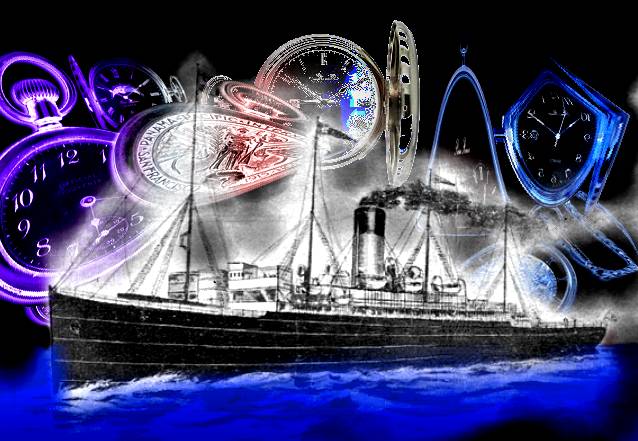
- HMTS Canopus
by Marcus L. Rowland
Copyright © 2004
| Worldbook | Main Index |
|
| Contents |
 INVENTED by Doctor Elliot Ferguson of Edinburgh University (right) in 1882, the Ferguson time displacer is a half-understood miracle of modern science. While what it does is easy enough to explain, the means by which it does so are as yet unknown.
INVENTED by Doctor Elliot Ferguson of Edinburgh University (right) in 1882, the Ferguson time displacer is a half-understood miracle of modern science. While what it does is easy enough to explain, the means by which it does so are as yet unknown.
Dr. Ferguson was attempting to develop a means of counteracting the magnetic field around iron-clad and iron-hulled ships, to make their compasses more accurate. He had achieved some modest success with an electrical method in small-scale tests, but at that point needed to experiment on a full-sized vessel. Having explained his work to the directors of Cunard, they allowed him to try his equipment aboard the steel-hulled liner Servia (7932 tons) during a coastal run from Southampton to Liverpool, with unexpected results; as soon as the equipment was activated the ship disappeared, to the great alarm of observers ashore. For those aboard the ship there was a wholly unexpected effect; the sun seemed to begin to reverse its course, going faster and faster as the ship steamed towards Liverpool, while the Displacer began to produce electrical discharges which made it impossible to approach. After about twenty minutes of confusion the Captain had the power cut from the engine room and returned to Southampton, where all aboard were astonished to discover that it was now the year 1880, more than a year before the Servia was launched! Needless to say there was considerable confusion, with the Police, Customs and Navy becoming involved. After several hours Dr. Ferguson was allowed to try reversing the polarity of the device, without any obvious effect. As an experiment his younger self was summoned from Edinburgh; although greatly surprised by the confrontation with his older self, he suggested that the motion of the ship might also be a factor in the displacement, and that movement through one of the physical dimensions was somehow being translated into a movement through time.
With some difficulty the authorities were persuaded to let the Servia sail again next day, with both versions of Dr. Ferguson aboard. This time the sun seemed to speed up. After approximately twenty minutes it abruptly stopped. The Servia returned to Southampton again, finding that it had returned to its own time, thirty-four hours after vanishing. This was exactly the time that had passed for those aboard the Servia.
All aboard were greatly surprised to discover that there was no record of the visit of the Servia, and that nobody they had encountered in Southampton two years earlier now remembered them. One obvious confirmation of this was that the original Dr. Ferguson had no memory of a visit from his future self or of visiting the future.
| |||||||||||||||||||||||||||||||||||||||||||||||||||||||||||||||||||||||||||||||||||||||||||||||||||||||||||||||||||||||||||||||||||||||||||||||||||||||
Where time displacement is measured in days, tonnage in Imperial tons, and distance travelled in nautical miles. No other variables, such as the power supplied to the time displacer or the vessel's speed, have any effect on the "distance" travelled in time, but the vessel's speed controls the rate at which it travels through time. If the device is deactivated, even for a second, the vessel must build up temporal momentum again. Distance travelled need not be in a straight line - it's possible to sail around in circles or put the ship into reverse without changing the temporal direction. For example, even after a week of travel a ship will be more or less stationary in time if the engines stopped, apart from any time movement due to drifting, but as soon as it starts moving again it will continue to travel through time at whatever rate it has attained. The velocities imposed by the rotation and orbital movement of the Earth don't seem to have any effect; nobody knows why.
The table to the right lists the temporal displacement theoretically possible for the Corinthic, a typical Time Ship. In practice the atmosphere becomes increasingly unbreathable prior to 300 million years BC. Another restriction is fuel; maximum range for the Corinthic is about 100-150 million years, since her bunkers hold fuel for approximately a 5000 mile round trip. This is extended by burning wood whenever possible, and the boilers are designed accordingly. Standard equipment for Time Ships includes logging equipment and chains for securing cords of wood to the decks. Remember always that a time ship's journey may also involve some normal sea travel at each end of the trip; while a journey to the really deep past covers several thousand nautical miles, shorter trips may be completed in an hour or two, and this can leave the ship with a considerable distance to travel at sea.
Spreadsheet templates for Excel and Lotus 123 can be used to determine performance for other vessels, at different speeds, etc.
Anything aboard a time ship, or within a few feet of its structure, travels with it. It isn't quite possible to jump high enough to be left behind, but a ball thrown upwards with moderate force will vanish, as will anyone falling overboard. Fortunately circulating fluids such as the water, air, smoke, and steam around a ship seem to be rapidly replaced by new material, fast enough that nobody is likely to suffocate. Having said this, in an experiment in which a time ship stayed stationary in the past without switching off its time displacer for several hours the scientists noticed that the air did feel somewhat stuffy.





| Contents |
 The Temporal Displacer (One of Corinthic's displacers is shown to the right; the photograph depicts the characteristic high-voltage discharge that accompanies time travel) is a series of complex windings about twice the size of an unbrella stand, bolted to the hull of the ship that carries it, with cables connecting it to the ship's electrical supply and to coils spaced at intervals along the ship's hull. In many respects it resembles the Tesla Coil, developed more or lass simultaneously, though the internal windings are different. In the early days Displacers broke down on several occasions, requiring rewiring and repairs to the hull coils before they could be reactivated. Two decades of development have improved the device considerably; there are now several main coils in a ship (Corinthic has four), with many more secondary coils dotted around the hull to reduce the chance of any failure. A bank of accumulators provides power for an hour or two, to allow servicing and repairs to the generator without shutting down the displacer. A modern installation costs and weighs roughly a pound per ton of ship that will be moved through time.
The Temporal Displacer (One of Corinthic's displacers is shown to the right; the photograph depicts the characteristic high-voltage discharge that accompanies time travel) is a series of complex windings about twice the size of an unbrella stand, bolted to the hull of the ship that carries it, with cables connecting it to the ship's electrical supply and to coils spaced at intervals along the ship's hull. In many respects it resembles the Tesla Coil, developed more or lass simultaneously, though the internal windings are different. In the early days Displacers broke down on several occasions, requiring rewiring and repairs to the hull coils before they could be reactivated. Two decades of development have improved the device considerably; there are now several main coils in a ship (Corinthic has four), with many more secondary coils dotted around the hull to reduce the chance of any failure. A bank of accumulators provides power for an hour or two, to allow servicing and repairs to the generator without shutting down the displacer. A modern installation costs and weighs roughly a pound per ton of ship that will be moved through time.
As adjuncts to the Displacer all Time Ships obviously need the best possible navigational instruments; any ship venturing more than a few years carries a suite of astronomical telescopes and equipment for calculating tides and drawing charts. Third-generation calculating engines, capable of several hundred operations per second, are becoming increasingly common. See Swiss Movement for the construction of complex analytical engines; minimum requirements are probably MIND [4] with a specialised Science (Navigation) skill, Speed, and Precision Arithmetic, with equipment for plotting charts and printing tables. This equipment adds a few hundred pounds to the price.
The impossibility of travelling beyond the present day is a great simplifier, of course; most of the navigational equipment is only needed to find a precise point in the past, then navigate a safe course back to the present - precise temporal navigation on the return journey isn't needed, it's simply a matter of avoiding hazards and waiting for the Displacer to stop working. Even so most Captains and navigators prefer to avoid surprises, and the last few hundred years of a return voyage are generally taken at a comparative crawl.
| ||||||||||||||||||||||||||||||||||||||||||||||||||||||||||||||||||||||||||||||||||||||||||||||||
| One-man Displacer | £151 | 11 lb. |
| Broadsword Aeronef | £169 | 29 lb. |
| Corinthic | £12,400 | 5.6 tons |
| Titanic | £46,400 | 21.0 tons |
There are no upper limits on mass, apart from a cost per ton and an assumption that the equipment is at least partially contained inside a metal hull. An early draft assumed no mass costs and described an experiment which accidentally moved the entire planet Earth several thousand years through time; unfortunately the Moon and Sun didn't go with it, and by the time the Earth got back to the right time it was well out of orbit and on a collision course with the moon, now orbiting the sun as a small planet. This is not recommended!
| Contents |
The most obvious uses for the Temporal Displacer are scientific and historical research, and for the less lawfully inclined looting on an unprecedented scale. It has also been used by Scotland Yard to solve some crimes. Increasingly the forces driving its development are tourism, hunting (essentially a version of tourism) and warfare.
Scientists are delighted with the opportunities the Temporal Displacer offers, though frustrated by some of its limitations. Astronomers would dearly love to set up a permanent observatory three or four hundred million years in the past, for example, but have been forced to settle for scattered observations from portable and shipboard instruments, and a few expeditions to observe events such as Tycho Brahe's "Stella Nova" of 1572.
Geologists have made enormous strides in their understanding of the Earth, and are beginning to develop a theory explaining the movement of the continents, but again the lack of a permanent long-term research facility in the distant past is frustrating. If powerful and reliable rockets are developed (see The Space Bubble) it might be possible to launch projectiles into space in various eras and take photographs of the continents, which would improve mapping considerably; unfortunately packing all of the equipment needed onto a single ship may prove difficult or impossible.
In biology, much to the dismay of creationists, evolutionary processes have been repeatedly observed over millions of years, and there appears to be no sign of Noah or any other form of supernatural invention in the preocess. The idea that Genesis is literal truth is virtually discredited, with most faiths assuming that it is simply an allegory of God's involvement as instigator of the biological processes that led to the higher species. Needless to say several fundamentalist sects have denounced time travel as an instrument of the Devil. Palaeontologists are naturally delighted with the opportunities available, but even they would prefer to set up permanent camps; many important species are rare in coastal areas, and the time a large ship can spend in the distant past is often too limited for a prolonged expedition inland. Specialists in more recent species, such as mammoths and other extinct mammals and birds, have a slightly easier time of it; with the geography much more like that of the present day it is easier to reach most inland areas, and the faster journey to the past means that they can spend more time ashore.
Note: The Society was an entirely real organisation, but in our world did nothing after 1865. Species introduced included American grouse, numerous foreign plants, various species of sheep, fish, amphibians, etc. Several are now regarded as pests. |
 Dodo (chicken-sized flightless bird)
Dodo (chicken-sized flightless bird)
BODY [1], MIND [1], SOUL [1]
Brawling [1], peck Effect 1, A:- B:B C:B/F
Wounds F [ ], I [ ]
Quote: [clucking noise]
Notes: A flightless bird related to pigeons but considerably larger. Usually found in forests, feeds on fallen fruit etc. Extant for several million years, extinct due to introduced predators and destruction of its environment circa 1680.
 Moa (Giant flightless bird)
Moa (Giant flightless bird)
BODY [8], MIND [1], SOUL [1], Athlete (Run) [8]
Brawling [9]:
Peck Effect 8, A:F, B:I, C:C
Kick Effect 10, A:I, B:I+KO, C:C/K
Wounds F [ ], F [ ], I [ ], I [ ], C [ ]
Dense feathers armour against all attacks -1 Effect and act as camouflage, -1 to attacks at long range.
Quote: [deep clucking noise]
Notes: A leaf and twig-eating flightless bird with an attitude, about 8 ft. tall when fully stretched (but usually bent over as illustrated and about 4-5 ft. tall) and aggressive if disturbed. Usually found in dense forests. At least a dozen subspecies. Probably extant for at least two million years, killed off by over-hunting about 1500 AD.
| Scenario Idea: Mediterranean Cruise About five million years ago the rising Atlantic began to fill a desert depression; the Mediterranean. It took only a few hundred years to spill over a colossal waterfall that is now the Strait of Gibraltar, wiping out an area of several million square miles and thousands of native species. Now the Zoological Society, the Natural History Museum, and America's Audobon Society and National Geographic magazine have decided to pool their resources to document this event, obtaining photographs and cinematographs of the process, capturing plants and animals before they are swept away by the flood, etc. The plan is to charter a suitable ship and travel back in the Atlantic to just before flooding began, send expeditions overland to the desert to collect plants and animals and document the area, then move forward in leaps of a hundred years or so to document the process from the shore, from balloons, etc. Once the Mediterranean is full the ship will cruise it, taking water samples and observing its colonisation by fish etc., again making multiple stops over several hundred years. With so many stops and expeditions the voyage will take about three to four months. To do all this and accommodate several dozen scientists for several months a big ship (such as the Corinthic or a similar vessel) will be needed, but there simply isn't enough money available to charter it for such an extended period. Unless someone can find a few wealthy sponsors, or attract some wealthy passengers who like the idea of a really long scientific vacation, of course. Or perhaps the adventurers are idle rich scientific dilletantes, and will be invited to book passage for the cruise of a lifetime. Less wealthy adventurers who are not scientists might instead join the expedition as ship's officers and crew, or have some unusual skill that's useful for the expedition; for example, if the campaign takes in powered flight it would obviously be very useful to bring along a small Æronef or some form of dirigible, and pilots etc. to man it. In a campaign taking in elements from The Queens Own Aerial Hussars soldiers might be assigned to the expedition. An optional complication; another liner from the future made a navigational error while travelling back through time and ended up in the Mediterranean basin as it was filling, ploughing to a stop in the desert sand several centuries before flooding began. Now several thousand descendents of the passengers live there. Their language seems to be a distorted version of American English, and their life-style resembles that of Bedouin and other desert tribesmen. They have completely forgotten their origins. Their ship, a huge liner that appears to come from a later era than the adventurers, is half-buried in a sand dune. If they stay in the basin their descendents will drown, but their ship is seriously damaged and in any case doesn't have nearly enough room for that many passengers. They now appear to be natives of the distant past so all of the rules about bringing them to the present apply; also, since the past can't be changed permanently any later expedition will find that they're still there, doomed unless they make their own way to safety in the deserts around the Mediterranean basin. What, if anything, can the adventurers do for them, and what will happen if they're somehow saved? Another optional complication; the temporal castaways are carrying a couple of nasty diseases and parasites that don't exist in the adventurers world; maybe a new influenza strain as potentially lethal as the Spanish Flu of 1918, maybe something as nasty as leporosy but more infectious, maybe really bad lice. |
| Scenario Idea: Saving President Lincoln One of the most thoroughly documented leaders of recent years was President Lincoln. Historians know when he lived and exactly when and where he died. Wealthy members of the Republican Party have had the idea of rescuing him from assassination and bringing him to the present to endorse their next candidate for the presidency.   Recently-elected Republican President Theodore Roosevelt is refusing to back the idea or supply any help - while he has nothing against Lincoln, his stated position is that he doesn't wish to set a precedent that will lead to officially-sanctioned "retrieval" of people from the past, in contravention of America's laws against involuntary temporal transportation. He doesn't believe that Lincoln would come willingly. An unstated reason is that Roosevelt is also a little worried that the party might select Lincoln as its candidate at the next election if his first term proves unpopular, since there's no law to prevent Lincoln running for a third term of office; indeed, current US law would regard such a temporal import as a new individual, see above and below. While there's a custom against standing for a third term, Lincoln served such a short part of his second term that he might be persuaded that it doesn't count. He also worries that they might think of trying the same stunt with his immediate predecessor, President McKinley, who was assassinated in 1901. Roosevelt only became president because of the assassination. Recently-elected Republican President Theodore Roosevelt is refusing to back the idea or supply any help - while he has nothing against Lincoln, his stated position is that he doesn't wish to set a precedent that will lead to officially-sanctioned "retrieval" of people from the past, in contravention of America's laws against involuntary temporal transportation. He doesn't believe that Lincoln would come willingly. An unstated reason is that Roosevelt is also a little worried that the party might select Lincoln as its candidate at the next election if his first term proves unpopular, since there's no law to prevent Lincoln running for a third term of office; indeed, current US law would regard such a temporal import as a new individual, see above and below. While there's a custom against standing for a third term, Lincoln served such a short part of his second term that he might be persuaded that it doesn't count. He also worries that they might think of trying the same stunt with his immediate predecessor, President McKinley, who was assassinated in 1901. Roosevelt only became president because of the assassination.
Despite the lack of Presidential support the plan is going ahead, but to minimalise government interference will be mounted from a British ship. All of the Republicans involved have promised that Lincoln will only be brought to the present if he comes voluntarily. The adventurers (who should be reasonably well-connected Britons) are asked to accompany the expedition as witnesses, to make sure that Lincoln is not coerced. At least one should be working for the British Secret Service, making sure (at the request of President Roosevelt) that the mission fails without any harm to Lincoln.. |
 Scenario Idea: Tales of the Black Freighter Scenario Idea: Tales of the Black FreighterSince time travel became a reality its criminal implications have been a staple of crime fiction, especially the penny dreadful crime magazine that one or more of the adventurers writes for. The publisher, wanting a story exposing the reality of the illegal traders, asks the author to go undercover aboard one of the worse ships. Nobody is quite sure what really goes on aboard the TS Hannibal, registered out of Paraguay but crewed by the worst scum of the London docks, but she invariably sails with a cargo of sugar and returns with several hundred thousand pounds in golden guineas. Customs suspect the slave trade, but there is simply no proof. Unless the adventurers can find it... Note: Tales of the Black Freighter was a comic mentioned in the excellent graphic novel The Watchmen |
| Scenario Idea: Ripping Yarns Even though they pre-date the Temporal Crimes Bureau the Jack the Ripper murders of 1888 are an obvious target for investigation by this method, but the police seem to be curiously reluctant to make the necessary moves. As a result of recent questions in Parliament there is a general feeling that something needs to be done. Why are the police dragging their heels? Could there be any truth in the rumours of Royal or Masonic involvement? 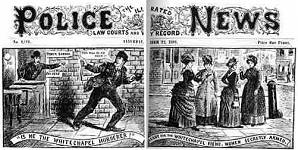
As the debate continues and the police excuses get less believable a gentleman sportsman proposes to take a hunting party back, entirely unofficially, and get the evidence needed to solve the case. Are the adventurers interested? There's one tiny snag... the Ripper is aboard the ship, and plans to make sure that the hunt will be unsuccessful, at least as far as he's concerned. To play fair, he (or she) should be someone known to the adventurers, either as another member of the hunting party or as a member of the crew, criminologist along to study the case, etc. If you want to get really complicated there is more than one Ripper - there is no definitive evidence that all of the crimes were committed by the same person - and the murderer aboard committed the later crimes. He hopes to make sure that the Ripper is caught early, then if the party doesn't return to the future he intends to stop his earlier self (if necessary by killing him) so that all the evidence will suggest that one person was responsible for all the crimes. Alternatively, there really is a complicated conspiracy afoot to conceal the true identity of the killer (The Duke of Clarence? Prince Albert? Agents of Queen Victoria herself?), and agents of the conspiracy are aboard, working to sabotage the investigation without giving the game away. Possibly at least one of the adventurers is part of the cover-up. But how many failures can they arrange before everyone realises that someone is sabotaging the enquiry? For more on the Ripper murders see numerous books, comics, films and web sites, e.g. a web site outlining the facts that doesn't attempt to draw conclusions, the official police site on the case, or the Wikipedia page on the case. |
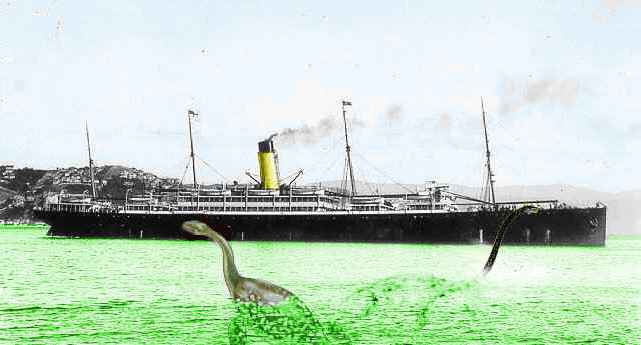 CORINTHIC (White Star Line) CORINTHIC (White Star Line)The Corinthic is a 12,251 gross ton ship, 500ft x 63.3ft, one funnel, four masts, twin screw, speed 14 knots. She has accomodation for 121 1st, 117 2nd and 450 3rd class passengers. She was built by Harland & Wolff, Belfast as a general purpose passenger ship which can service Atlantic, Pacific or trans-temporal routes with equal ease, and has refrigerated cargo holds. All of the equipment for time travel and temporal navigation is permanently installed (and can be useful for avoiding storms and ice on the trans-Atlantic run), for a temporal journey it is simply necessary to ensure that sufficient supplies and coal are carried. On longer temporal journeys fewer passengers are carried, which both reduces the need for supplies and makes room for more supplies and equipment; typically on a long cruise only 100-150 3rd class passengers will be carried, the servants of 1st and 2nd class passengers, with the rest of their accommodation used for supplies. Auxilliary craft carried aboard include lifeboats (for about half the passengers) and two small steam launches. For time trips she also carries small sailing craft appropriate to the times she will be visiting, purchased by previous expeditions. |
| A Note on Quarantine All ships visiting the past, especially liners, are required to go through rigorous quarantine procedures if anyone aboard has been in contact with any infectious disease, or is showing symptoms that might relate to such a disease. Quarantine typically takes a day or two if there is no sign of illness aboard, a week if there is one person ill, 2-3 weeks if more than one patient is affected. Certain periods and locations are subject to much more stringent quarantine, usually because of known epidemics such as the Black Death. |
| Scenario Idea: If it's Tuesday It Must Be Bosworth The TS Corinthic represents the expensive end of the travel market. The TS Sapphire does not. She's just big enough to mount a temporal displacer, and has accommodation for about 200, equivalent to third class cabins. She's used to take tours back to some of the major events of British history, rarely venturing far from the British coast or jumping more than a hundred years or so between stops. A high proportion of her passengers are school parties, typically a teacher or two with fifteen or twenty students, many of whom are away from home for the first time. A proportion of these students and teachers are impressionable young women, some of whom are well below the age of consent, and all of her officers and men have learned by bitter experience that it's essential to avoid any suggestion of intimate contact with them. The inevitable result is lawsuits, angry parents, and possible criminal charges. For reasons that are left to the referee the adventurers are forced to hide out aboard the ship; maybe they're on the run from the police or their bookies, maybe there's some suspicion that some of the crew are involved in smuggling (they aren't) and the adventurers are there to investigate. Whatever the reason, the adventurers have been forced to stow away, and must somehow stay out of sight aboard a crowded ship for two weeks. And of course the girls find them first... Play this one as light relief, along the lines of a Carry On or St. Trinian's film or Some Like it Hot, with the adventurers forced to duck and weave to avoid discovery and the romantic attentions of the schoolgirls. If they seem to want to take advantage of the schoolgirls, remind them that only a cad and a rotter would do so. Then arrange a series of silly accidents to add maximum embarassment and prevent anything untoward from taking place. Note: If there are any female characters there should be some reason why they have been forced to disguise themselves as men, and stay in disguise despite the current situation. They should receive even more female attention than genuinely male characters... For an optional complication one or more of the younger women aboard falls in love with a native of one of the time periods visited and tries to smuggle him aboard and back to the future. Alternatively, she tries to elope with him and stay ashore when the Sapphire is ready to sail, or is abducted by him. Her suitor has a large number of friends who will try to defend the lovers from any attempt to return her to the ship. |
| HMTS Canopus
The first Canopus-class battleship, 14,320 tons (modifier 3.54, BODY [100]), 4 × 12" guns, 12 × 6" guns, 22 lighter guns, 18.3 kts. Portsmouth Dockyard, 1899. The first of six light battleships ordered in 1896, designed from the outset for time travel. Canopus mounts three Temporal Displacers, and needs only one for time travel, with a highly redundant network of hull electrodes ensuring that she can take considerable damage before her ability to travel in time is compromised. 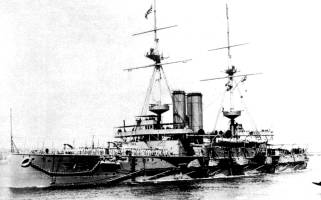 |
Time travel might be used for tactical manoeuvres in battles between ships, but there are problems; in a fight between two ships, both equipped with temporal displacers, the most likely result is that both would find their enemy vanishing as soon as they came close to gunnery range. Battles would have to be fought by guesswork and prediction of the enemy's movements in time as well as space.
At its simplest a warship might identify an enemy craft at a distance, dive into the past while simultaneously closing with it, then return and "surface" in the present for the attack. While the temporal displacer is working the warship is immune from attack, unless it has the misfortune to come under fire or hit a mine in the short time it must spend in the past to change its temporal direction. There are snags, of course; if things go badly wrong the warship might have to fight in the past as well as the present, without any possibility of affecting the enemy's ability to fight the final battle.
Time spent in the past can't be recovered; if the manoeuvre takes five minutes, the attacker will "surface" five minutes after it vanished, and in that time the enemy may have changed course, sent a signal requesting help, or received reinforcements. For these reasons warships need to be fast, capable of closing with an enemy quickly and changing temporal "course" so far in the past that there is little possibility of hitting a mine or engaging the enemy without adding any unnecessary delay. Even then it's difficult to guess which strategy would be most effective. For example, if HMS Canopus wished to fight another ship at a range of twenty nautical miles she could dive back into the past for 30 minutes, going back 7.4 years and covering just over nine miles. It's unlikely that the enemy would happen to (a) be the enemy and (b) have ships or mines at exactly the right place that far in the past, and in any case Canopus would only be there for a half minute or so. She changes temporal "course" and returns to the present, and in theory might "surface" only a mile from the target... but of course the enemy has had an hour to prepare for the fight, and may have changed course, received help, or departed for the past as soon as Canopus vanished!
It might be a better idea to use short jumps instead, but that increases the probability of disaster in the past; for example, a five minute stage will take the Canopus only twelve and a half days into the past, and even if that's shortly before the outbreak of war it's entirely possible that a determined foe planning such a war, or expecting an attack, will be ready for an enemy ship to appear. Cases can be made for and against every possible combination of moves and it will take bitter experience, and consequent loss of life, to determine which are correct.
One technique that is theoretically possible is to carry out probing attacks against an enemy in the very near past (a figure of five or ten minutes has been suggested), observe how the enemy responds, then use the information obtained to carry out a "real" attack against an enemy who does not know that you have repeatedly attacked his shores or fleet to perfect your technique. Of course this assumes that you are prepared to risk losses, but combined with the other techniques outlined above they would probably be light.
A similar method could be used for espionage. Briefly, it would be possible to land spies a few hours or days in the past and send them to obtain any desired information. If they are caught the ship returns to the present, leaving the spies to vanish along with the world in which the enemy is aware that espionage has taken place! It might even be possible to use spies from the earlier period, so that nobody from the present takes any risk. There are probably agents prepared to take this chance in the knowledge that a later version of themselves will continue to exist.
| The Sorcerer's Apprentice Why limit this to supplies and ships? Potentially anything can be doubled up indefinitely given a time machine and the will to use it. Put a gold guinea onto a landing stage, wait a couple of minutes, travel back in time one minute, take the coin, and bring it back to the present. Put the two coins you now have onto the landing stage, wait couple of minutes, then repeat the proces, again and again and again. In only ten repetitions you will have 1024 coins. Twenty repetitions give you 1048576 coins. Congratulations, you're a millionaire. Thirty.... well, you've just made gold worthless, and the pier collapsed under the weight. Referees need to think VERY carefully before allowing adventurers to try this technique. Reasons not to? Maybe the engines will'na take it, Captain, but it's more likely that one of the situations mentioned in the referees information below will happen first. Or if money becomes worthless and manufacturing and farming are obsolete maybe society collapses. Incidentally, this method could be the answer in the scenario outline Tales of the Black Freighter above; the sugar is sold to buy gold, then this procedure is repeated a few times. |
| Scenario Idea: The Devil's Workshop Note: This is a crossover with The Queen's Own Aerial Hussars and Swiss Movement. "Good evening, Gentlemen. I'm Colonel Bulmer of Military Intelligence. I've been sent back from the end of the month, because we have a bit of a sticky situation on our hands." "On Wednesday morning next week a German citizen, Otto Holtz, will be arrested on espionage charges in Vienna. Germany will then deliver an ultimatum demanding his release within twenty-four hours, which the Austrian Government will find unacceptable. On Friday morning at seven units of the Imperial Prussian Army will cross the border into Austria at several points, and the entire country will be in German hands in a matter of days." "This is obviously a well-prepared invasion, and it will begin with the destruction of several Austrian border forts. We believe that they will be destroyed by a weapon the Prussians have code-named Kobold, which is currently in the last stages of assembly in the Krupp armaments complex outside Essen. Our intelligence suggests that it's some sort of tunnelling machine, beyond that all details are sketchy. We desperately need more intelligence; while it's too late for Austria, our French and Belgian allies are probably just as vulnerable to this weapon." "We're tried to infiltrate the factory over the last few months, with indifferent success, now we feel it's time to take more direct action. Your mission will be to carry out an all-out raid on this facility, capture all relevant documents and plans, and transport them to our time-ship, HMS Canopus, which will bring them back to the future. Those of you who are familiar with time travel will know that as soon as the Canopus starts to return to the present this segment of the past will be erased, and the Prussians will never know that their factory has been attacked." "Any questions?" As the briefing continues it should become apparent that Bulmer regards the inhabitants of the past as second-class citizens, not quite real. This should be played fairly subtly; for example, a round trip to Essen from anywhere in Britain is pushing the range limits of Broadsword- and Rapier-class æronefs (respectively 660 and 700 miles); they'll have the range to get to the target then on to Canopus in the North Sea, but not to get home afterwards. Unless someone points out this omission and pushes for fuelling arrangements to be made he won't consider their fate after they hand over the material from the factory. He isn't at all concerned about injuries to the soldiers or workers at the factory; after all in the "real" world the Hussars never went into action, so everyone is presumably alive and well. This doesn't mean that Bulmer is a bad officer; he's simply thinking in accordance with military doctrine and the temporal theory of the day, and hasn't thought through the idea that to the soldiers it will feel like they are being sent off on a suicide mission. Use the information on the Kobold project and the Krupp factory in Essen in Swiss Movement to plan the mission, but don't tell the adventurers too much about the factory's defences, the location of plans and other document, etc. Let them work things out for themselves, run the mission, then resolve the consequences in accordance with the referee's information below. |
| Contents |
| WARNING - REFEREES ONLY If you're going to play a character in this setting DO NOT READ ON - there's information in this section which may spoil your enjoyment and will certainly ruin many of its surprises. |
If you like everything above can be true, and it really isn't possible to change the past. You can run a reasonably satisfactory campaign that way, but that's not what this section is about...
Think about it. Ships going into the past are isolated, can't get help in an emergency, and have no way of returning if the displacer is destroyed and another can't be built. But they nearly always come back. There's something odd about that, isn't there? The idea that the past can't be changed is just that. An idea. There is no evidence that the past has been changed, even after attempts are made to change it. Therefore, it's assumed, time can't be changed. It's an assumption, and it's wrong. The adventurers come from a world at the extreme edge of a probability curve.
| The "U" Word And Other Problems It's difficult to discuss this without invoking the Uncertainty Principle, Quantum Mechanics and the Many Worlds Hypothesis, but you really don't want to use those words. Nobody in the early years of the twentieth century should be clear on these ideas, most won't be developed until the 1920s or later, and it will take a LOT longer for the implications to sink in. Unless they are VERY unusual characters the adventurers should have the classical physics view of the universe, in which everything is deterministic if you can describe it in enough detail, or believe (with Einstein) that God does not play dice with the universe. Given the evidence some may even believe that history follows God's pre-ordained plan, which explains why it can't be changed. |
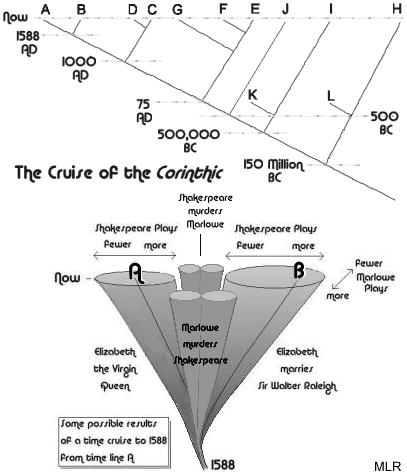 The diagram to the right is an extremely simplified view of just a few of the changes produced by the cruise of the Corinthic detailed at various points above.
The diagram to the right is an extremely simplified view of just a few of the changes produced by the cruise of the Corinthic detailed at various points above.
| Adventure Idea: Saviours of Herculeneum Returning from the distant past, the Corinthic docks in a Romanised version of Britain. Everyone speaks a distorted version of Latin and the adventurers are treated as oddly-clothed freaks. The technology is at least as advanced as the world they left, with electric chariots instead of cars and carriages, huge dirigibles and winged aircraft, silent pneumatic monorails, ships that look faster than the Corinthic and don't seem to produce any smoke, and electricity used everywhere. Everyone looks reasonably happy, apart from the porters on the docks who appear to be slaves. Sooner or later the local Prefect arrives and has the ship securly chained and guarded to prevent a getaway (unless the adventurers have already persuaded the captain to make a run for it) and representatives of the passengers and crew taken for (polite) interrogation. The Prefect has nobody who can interpret English, since the language never existed, but speaks Latin and a little Ancient Greek (with what seems an odd accent to anyone who was taught in a British school) and can find interpreters for Hebrew, Han Chinese and Mayan if anyone speaks those languages. If the adventurers do speak Latin he'll find their accents "barbaric but just about comprehensible", but tends to try to communicate by saying things slowly and loudly if they don't seem to be understanding him. Sooner or later someone will probably mention time travel, at which point the Prefect excitedly asks if the ship visited Herculeneum. If they admit to it he immediately becomes very deferential and hails them as the "saviours of the Empire"; records show that the warnings of the strangers on the "floating island" saved the lives of nearly three quarters of the population of Herculeneum and Pompeii. Their dramatic stories revitalised the faith of Rome, sweeping away false idols and gods. Such as Christianity, though he won't mention it if he isn't asked... The Empire now rules about a third of the world, the other major empires being centred on China and Mexico. Things ought to go reasonably well provided the adventurers don't make a fuss about slavery or Christianity. The Prefect will provide help, including homes for everyone aboard, in return for the secret of time travel. If the spokesmen for the Corinthic don't seem keen to co-operate he will start to insist, of course... Play this as friendly at first, with the Empire only showing its claws if the adventurers don't want to cooperate. Given their historical importance nobody aboard the Corinthic is going to be abused too badly, but anyone who doesn't speak Latin will invariably be regarded as a barbarian. The big problems for most outsiders are likely to be religious intolerance - you really don't want to say anything bad about the gods or promote any religion that the Empire suppresses, such as Christianity - and slavery. Slaves are generally defeated rebels and natives of conquered nations and their descendants, criminals who have been sentenced to slavery as an alternative to execution (yes, promoting Christianity is potentially a capital offence), and an occasional debtor who voluntarily enters slavery to pay off his debts. They are allowed to save money to buy their freedom, but it isn't easy. Currently the Empire has stable borders, so most slaves are rebels, prisoners, and debtors. What the Prefect doesn't say is that the Empire is stagnating, a victim of its own success; nobody wants a war (all three Empires have had chemical weapons of devastating power for the last two hundred years or so) and there are no major areas that don't already belong to one or another empire. After centuries of peace and prosperity most of the formerly conquered areas are now inhabited entirely by Roman citizens, and the underclass that did most of the dirty work is slowly vanishing. To an extent automation is replacing it, but that erodes the role of slaves, which leaves one of the major stabilising institutions of the Empire - the threat of enslavement - as an increasingly uneconomic option. It hasn't quite reached the point of costing the Empire money to enforce the system, since there is still a market for domestic slaves, but outside the home slavery is virtually obsolete. The dock labourers belong to the state, and spend most of their time waiting idly in barracks until a job comes up that can't be handled by cranes, conveyor belts, etc. Time travel would be an answer to this problem; it would give the Imperial armed forces something to do, a new frontier that will justify their existence, opportunities to conquer and loot... and slaves could be used to build Roman colonies in the past, a good way to get rid of the less ornamental ones that can't be sold on the domestic market. If the adventurers (or someone else aboard the ship) explain how the Temporal Displacer works they'll be helping to create misery in a myriad of new timelines. Unfortunately it isn't very difficult to work it out; the controls aren't really much more than "on" and "off", "past" and "future", and a few adjustments that are basically "trimming" settings to minimise power consumption and stop anything burning out, already set correctly for the Corinthic and not vitally important, which can easily be figured out by a competent electrician. The complex winding of the coils is the only "secret", and even that can be worked out by taking one apart; the Corinthic has several main coils and hundreds of hull coils, so the Romans have several chances to get things right. Stopping them will be much harder once the ship is in their hands. It's possible that the adventurers will decide to settle down here and co-operate, and if they do the referee shouldn't try to stop them. Give them time to get comfortable, and to see stories about Roman conquests in the past, then have a Mayan snatch squad turn up looking for the secret of time travel... |
Introducing this idea can be tricky. While it's possible to throw the adventurers in at the deep end, coming back from a trip to discover that history has changed (or rather, that they are in another world where history has always been the way it is), it's probably best to drop a few hints first. Hints need not necessarily be obvious; just little glitches that seem meaningless until you really think about them. For example, if the adventurers think of trying the money multiplying trick described above, let them get to a few thousand pounds, then the next time round the money left on the shore has disappeared when their ship returns to the present. There might be a newspaper story describing Scotland Yard's co-operation with officers from the future, and speculation on why there seems to be a record of the vist this time, or a furious diplomatic argument about a brazen act of espionage by foreign agents.
How easy is it to get back to your original world? While theory suggests that it's practically impossible, it's probably a good idea to let players get away with it at least once. After that the outcome is mostly a matter of luck, and (unless you want the adventurers to come up with an invention for crossing between time lines or choosing the right one as they leave the past) heavily loaded against them.
While it would be possible to develop elaborate rules for historical significance etc. they're difficult to administer and the essential point is that sooner or later the adventurers are going to run out of luck. The easy method is to give each stage of a time journey a Difficulty from 1 to 6 based on the historical importance of the place and time visited, modified by -3 to +5 for anything that the visitors may have done to protect or disrupt the original course of events, with an additional modifier of -2 to +2 if it's something done by the adventurers. For example, on the cruise of the Corinthic the first two stops might go as follows:
Once on a new time line there is no going back; all that it is possible to do is to attempt to create another time line, and hope that it's like the one that the adventurers came from. They may not initially know this - even after time has changed there's no guarantee that they'll draw the right conclusions - and they almost certainly won't realise that every attempt to make their ideal world is creating millions in which they failed. All of which still contain the adventurers!
Viewed in this light all of the uses for time travel described above are creating vast numbers of time lines, many of them very different from their originals:
| Contents |
The most likely problem for players in this setting is a return from the past to discover that history has changed, as described above. There are some other possibilities - their ship could be wrecked or break down in the distant past, or they could be marooned in the past by an accident or malice - but a change of time line is the most likely and has the most potential for a continuing campaign. Once this occurs they'll need to decide what to do about it. The main choices are to stay in the altered world and hope that they can find happiness there, or to return to the past and try to put things back the way they were. Some other campaign ideas are described below.
Colonising an altered "now" can be tricky, even if the newcomers are welcome. There may be problems of race, language, and religion, or in worlds that were changed in the distant past the dominant race may even be of a different species; e.g. Homo Erectus or a greatly altered Homo Sapiens in a world where the past was changed in 500,000 BC, possibly intelligent dinosaur-descendants if the change was made in 150 Million BC. Different doesn't necessarily mean bad; the reptilian dwellers of "Now" H might be vastly intelligent philosophers, quick to learn human languages, deeply compassionate of the poor mammals and their problems and eager to help - so eager that the adventurers start to feel smothered by their concern and love. Or they might want to invite the humans to lunch without making it clear that they're on the menu, of course...
 The S'sssksskss The S'sssksskssThe S'sssksskss are a sample alternate race for this setting, a reptilian race whose ancestors (which were at that point about the size of rats) survived the extinction of the dinosaurs. For some reason the mammals died out around that time (S'sssksskss scientists believe that they were wiped out by some contaminent thrown up by an asteroid impact, possibly water-borne bacteria) so the eventual winners in the evolutionary battle were mostly reptiles. They look vaguely like large iguanas, on average about 6ft 6in tall, with their tails used to stabilise their upright posture. They're omnivores living on a mixture of vegetables, fruit, and invertebrate foods such as worms (they breed nearly two hundred subtly different species, each with its own unique taste), slugs, and snails. They mostly don't particularly like meat or fish but can eat them if they have to; they think of them as exotic foods, not as staples. They bear their children live, in clutches of two or three (very rarely one or four), and rear them much in the way that humans do, except that initially both parents chew food for the infants until their teeth develop. It's believed that the resultant puree contains useful bacteria and antibodies which colonise the bodies of the young and improve their health; young fed on mechanically pureed foods are less healthy. Population density in their cities is a little higher than for humans, with an emphasis on tall residential towers, but there are still occasional villages, loners, etc., since they are as varied as humans. Although humans might describe them as cold blooded (the technical term is poikilothermic, obtaining warmth from their surroundings) they are almost always warm to the touch. They gain body heat from the sun and heat sources such as fires, warm lamps, etc., and in the last few hundred years from electrically-heated clothing. They believe that the initial spur to their intelligence was the struggle to find warmth during an ice age. They think that they've been intelligent fire-users for about two million years, with most historical records beginning about thirty thousand years ago and the scientific method developed about three thousand years ago. They're considerably more advanced than the average Victorian/Edwardian scientist in most areas of science; the main field that is lagging is astronomy, possibly because they have poorer night vision than humans and find the stars less interesting. Their senses of hearing and smell are very acute, and their arts reflect this, with incredibly complex music and rich "smell panoramas" commonplace. In their native world and time there are at least twenty distinct S'sssksskss nations, all of which seem to have rapidly-changing borders and are primarily associations based on mutual interests, each with its own language and traditions. There is as much variation between S'sssksskss as there is between humans, and their cultures range from pacifist monks (yes, they do know lethal self-defence techniques) to heavily-armed military dictatorships. Nearly all S'sssksskss change nation several times in a lifetime of two to three hundred years, and they are very good at learning languages, down to the original speaker's accent. Once part of a nation (or even when visiting it for an extended period) they adopt its customs, clothing, language, etc., going "native" so far as it doesn't conflict with their personal beliefs. If there is a real conflict of interest they will usually leave, rather than fighting or trying to buck the local system, but will certainly fight if they have to. Few S'sssksskss would dream of stopping them. They will typically pick up human languages and habits in a few days. To their eyes humans look freakishly odd, but not offensively so; they smell awful, but fortunately S'sssksskss can close their nostrils and ignore it. They will always expect humans to learn their languages and customs just as easily, and will be mildly offended if they don't, but their languages are VERY difficult for humans, -2 to Linguist skill. One exception to this; anyone who has previously learned a language that uses tonal clicks etc. such as Bantu has no negative modifier. S'sssksskss time ships are typically huge twin-hulled designs, almost floating cities. They discovered quantum theory before they invented the Displacer, and guessed from the outset that they were likely to change time-lines; accordingly each is a self-contained world, a city carrying everything needed to sustain a nomadic life or found a new civilisation. Generate S'sssksskss on 28 points with the linguist skill free at MIND +1. Average characteristics are 4-5, with 6-7 high but still reasonably common. They have two natural attacks, Claws and Bite, both with the usual default damage etc., and may also know Martial Arts, Melee Weapon, etc. Due to their mental agility they have one odd attribute; extreme adaptability. In game terms they can move points from one skill to another that uses the same characteristic. For example, a S'sssksskss with Brawling 5 and Athlete 6, both based on BODY 4, could concentrate on a series of combat moves for several days while neglecting other athletic pursuits and end up with Brawling 6 and Athlete 5. They can't modify characteristics this way. |
At best anyone settling in an altered timeline will feel isolated and a little alien, even if the changes were only made a few decades ago. In fact recent changes are probably more unsettling than a completely alien society; imagine returning to a world where the French won at Waterloo or Britain is part of the American Empire. At worst the adventurers and their shipmates might be second class citizens, potential slaves, or potential lunch. They might be more technically advanced than anyone else, or treated as primitives who still think that steam and electricity are exciting technological innovations.
So how do you change the past back to the way it was? The simple answer is that you can't. A more complex answer is that you can create something very similar, but it isn't your original universe, and there will be multiple versions of you that don't get to go home. The trick is actually very simple - go back to shortly before the time that you think the time-lines split, stay well out of the way of trouble (in the middle of an ocean is probably as good a place as any, but try not to run anything down or dump too much rubbish) for an hour or two, then head for home without stopping en route. If you're lucky you'll end up in a time line that's similar to the one you left. It can't be identical - there are too many random variables - but some similarity to the old time-line should be restored. Exactly how close it is should be left to the discretion of the referee, but the main factors should be how long ago the change was made and how lucky the adventurers are, rolled against the Difficulty of avoiding the change (as described above). Some variables that might be affected:
All things being equal, the referee is strongly advised to adjust things to fit the needs of the adventure, rather than rolling for everything. Think of TV series such as Sliders or The Time Tunnel and give the players some new problems every time they try to restore their original history or settle down, without worrying too much about plausibility or rolling dice.
| Contents |
Once the adventurers begin to learn that time travel doesn't work the way it's supposed to, several types of campaign are possible. Time travel (initially as explorers, tourists, etc., later looking for a new home or trying to create a close approximation of their old one) is the most obvious, as outlined above, but there are some other possibilities. Elements can be combined to suit the inclination of the referee and the players:
 "experimental historian" changed the recent past and came back to find that his changes are a matter of record.
"experimental historian" changed the recent past and came back to find that his changes are a matter of record.
A campaign that begins with the characters as natives of the past. A time ship from the future calls in at the port nearest the adventurers' homes; maybe it's Herculeneum in 75 AD, London in 1588, or somewhere else entirely. Somehow they manage to get aboard, possibly intending to have a look around and maybe "borrow" some trinkets, possibly intending to stow away from the outset. They are carried off into the past or future and have to make new lives for themselves.
Another way to play this is for the adventurers to be natives of the "present" (1900-ish) when a ship from the future turns up, as described above. The Utopian visitors from the 1950s regard the early 20th century as a barbaric era, when people commit crimes and pry into each other's privacy, but aren't quite suspicious enough. Despite their precautions the adventurers manage to get on board...
In this type of campaign the main theme will be culture shock; the adventurers simply aren't ready for the world of the future, and the future isn't really ready to handle them. Despite (hopefully) good intentions the adventurers keep doing things that scandalise, puzzle or disgust their hosts, or vice versa. For example, the Utopian future might think that tobacco is disgusting, or the adventurers might suddenly realise that money and power in the sense they understand are long obsolete. Examples of this type of culture shock can be found in Edith Nesbit's The Story of the Amulet (in FF VIII) and in many stories dealing with cryogenics etc. such as Wells' The Sleeper Awakes, the film Sleeper and many TV SF series.
 An obvious variant on this theme is for the ship to be lost in time, or about to be lost. For example, a Roman ship from the world described above might dock in our Liverpool after a trip to the deep past. The Utopian ship could be on its way back in time, never to return home. Maybe the ship that the adventurers board is a S'sssksskss floating city, a self-contained multi-generation colony containing everything needed for a totally alien culture, with occupants happy to cruise the timelines, finding interesting places to visit and trade for supplies and raw materials: "Oh Zk'sss'sss, this city is so primitive... and those dreadful mammals! Ugh, such a horrible smell! Still, the idiots don't even know about fission reactors, uranium ore ought to be cheap."
An obvious variant on this theme is for the ship to be lost in time, or about to be lost. For example, a Roman ship from the world described above might dock in our Liverpool after a trip to the deep past. The Utopian ship could be on its way back in time, never to return home. Maybe the ship that the adventurers board is a S'sssksskss floating city, a self-contained multi-generation colony containing everything needed for a totally alien culture, with occupants happy to cruise the timelines, finding interesting places to visit and trade for supplies and raw materials: "Oh Zk'sss'sss, this city is so primitive... and those dreadful mammals! Ugh, such a horrible smell! Still, the idiots don't even know about fission reactors, uranium ore ought to be cheap."
Another variant is for the ship to carry pirates, raiders or slave traders, who carry off the adventurers as prisoners or slaves. Maybe they're raiders from a 24th century Viking culture, with a giant flying ship and incredibly powerful weapons, or a military expedition set out to scout the past and returning to the present to find that everything has changed. Or carnivorous intelligent reptiles, of course, loading up on snacks...
| Contents |
During play-testing several people asked me why I'd chosen this particular form of time travel, and limited it to big ships. The answer is a little complicated...
I don't honestly believe in time travel, but I think that if it was possible at all it would always change the past, either by replacing the previously existing turn of events or by splitting the time line. Hawking and others suggest that time line splits happen continuously, at everything from the quantum level upwards, billions of times a second. While it's difficult to imagine a universe that works that way the evidence and theory appear to be reasonably good, more convincing than for a single time line.
The same theories suggest that it won't be possible to travel between time lines, and I've fudged that a little in sending time travellers back along their existing time lines, as well as to the new ones. If that didn't happen time machines would be an unknown quantity; switch on and you disappear, never to return. It's unlikely that many would be built, or that many people would be stupid enough to try them.
Time line splits simplify game design and play; since you're never in exactly the same time line twice you don't have to worry about avoiding time paradoxes, tracking fights that move backwards and forwards in time, and some of the other complications that sometimes make time travel RPGs into a complex book-keeping exercise. It's just about possible to help your original past self (but you still need a ship and crew, transport from the coast to wherever you're in trouble, etc., and it isn't actually going to do the current you any good!), but there is no way for two separate instances of the same time traveller to interact in the past. You can't create an instant army by travelling back to the past again and again; you can do it by bringing the same person to the present again and again, using the "Sorcerers' Apprentice" trick, but there will always be time lines where it doesn't work, they are separate people (and will not regard themselves as expendable) and they can never go home again.
Restricting travel to the past (of the time machine, though players may initially think that there is an absolute ban on travel past their own time) is another way to keep the game controllable. Adventurers can't easily go past their own time to get ridiculously powerful weapons and other cool stuff from the future. Incidentally, does anyone really think that a futuristic government is going to let primitives from the past buy amazingly powerful weapons? No, me neither...
Another common problem is the use of time machines to bypass defences. In many games it's possible to materialise before a fortress or bank vault was built or after after it was destroyed, move your time machine there, then move through time and materialise inside the defences. Characters can easily bypass bodyguards, vault walls, etc., which makes it more difficult to give them a challenging situation. Use of ships avoids this problem completely, and will usually leave characters with the additional problem of getting ashore, locating transport, dealing with the natives, etc. It gives them more to do, and ensures that they'll have to interact with the local situation. Hopefully they'll end up seeing the natives as people, not targets. The need for movement and the lower mass limit of 2400 tons help to ensure that ships have to be built, since even today that much weight is difficult to move any other way.
Another reason to limit time travel to ships is that a vessel with several hundred people aboard can generate endless plots of its own; even a freighter will need a lot more crew than the average group of adventurers, so there can be plenty of NPCs with plans of their own, or an uncanny ability to accidentally mess up the adventurers schemes. An ocean liner is almost a floating town; it can survive on its own resources for several weeks, much longer if food and fuel can be obtained locally, and will carry a doctor and nurse with a fully-equipped surgery, mechanics and workshops, members of any reasonably plausible profession, and endless people with potentially useful knowledge. If you're going to get lost in alternate time-lines or marooned in the distant past they're going to be needed. The metal and other materials in the hull can also be very useful in this type of situation. It may also be worth mentioning that a liner probably contains enough people of child-bearing age to repopulate the world without in-breeding problems, which may be very helpful if it's wrecked in the deep past or an alternate time-line without people.
My final reason for writing it this way is that I think it's fun, which is something that occasionally gets overlooked in justifying how RPGs work. I love the idea of Queen Elizabeth I negotiating with the officers of a time liner, the Corinthic cruising past a school of plesiosaurs, the sky over the ocean lighting up as an asteroid plunges into the Gulf of Mexico half a world way, staid Edwardian naturalists wrestling with a moa, giggling Victorian schoolgirls meeting Da Vinci and Michaelangelo. I think it works, and I think it's fun. I hope that you'll agree.
| Contents |
Special thanks to "Captain Boulanger", Simon Bradshaw, Peter Cohen, Paul Cray, Mavis Cruet, Paul Drye, "Sir Ernest", Matt Goodman, Chris Halliday, Don Sample, Charles Stross and many others for their encouragement, help and feedback while I was developing this section.